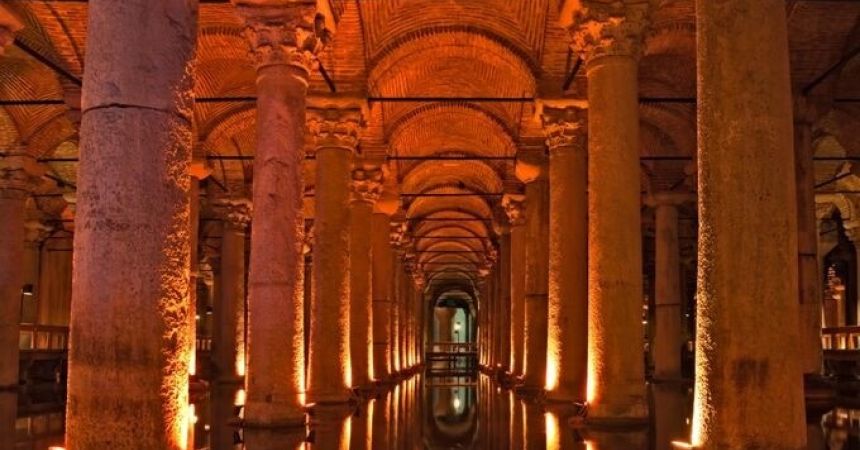
Istanbul Basilica Cistern
Beneath the bustling streets of Istanbul lies a hidden gem that whispers tales of ancient grandeur and mystery. The Underground Basilica Cistern, or Yerebatan Sarnıcı in Turkish, is a subterranean wonder that stands as a testament to the architectural ingenuity of the Byzantine Empire. With its eerie ambiance, majestic columns, and intricate carvings, this underground reservoir offers a unique glimpse into the city's storied past. In this blog, we will dive deep into the history, architecture, and visitor experience of the Basilica Cistern, uncovering why it’s one of Istanbul’s most fascinating attractions.
A Glimpse into History of Cistern Istanbul
Origins and Construction
The Basilica Cistern was constructed during the reign of Emperor Justinian I in the 6th century AD, around 532 CE. The cistern was built to supply water to the Great Palace of Constantinople and other important buildings in the city. Its construction was a marvel of engineering, demonstrating the Byzantine Empire’s advanced understanding of hydraulic systems and architecture.
The name “Basilica Cistern” derives from the fact that it was originally located beneath a large basilica (a public building or court) that was destroyed. Today, the cistern is often referred to as “Yerebatan” (which means “sunken”) due to its subterranean nature. It was designed to be an immense underground reservoir, with a capacity to hold up to 80,000 cubic meters of water.
Historical Significance of Basilica Cistern Istanbul
Throughout its history, Visit the Basilica Cistern played a crucial role in Istanbul’s water supply system. During the Byzantine era, it provided water to the Great Palace and other important structures, ensuring a reliable source of water even during sieges. In later centuries, the cistern fell into disuse and was largely forgotten until its rediscovery in the early 20th century.
Architectural Marvel of Cistern Istanbul
Design and Structure
The Basilica Cistern spans approximately 138 meters in length and 64.6 meters in width, making it one of the largest of its kind. The ceiling is supported by 336 columns, each standing about 9 meters tall, arranged in 12 rows of 28 columns. These columns, made of recycled materials, showcase various styles, including Corinthian and Ionic capitals, reflecting the diverse influences of the Byzantine era.
The cistern’s floor is paved with large terracotta bricks that help to distribute the weight of the structure and prevent leakage. The columns are spaced in a way that allows visitors to walk along raised wooden platforms, providing an unobstructed view of the watery expanse below. The dim lighting adds an aura of mystery and enhances the dramatic effect of the surroundings.
Artistic Features
One of the most intriguing aspects of the Basilica Cistern is its decorative elements. The most famous of these are the two Medusa heads that serve as column bases. These heads are positioned at the western end of the cistern and are believed to have been repurposed from an earlier structure. Their origins are shrouded in mystery, and their presence adds an enigmatic touch to the cistern’s atmosphere.
The Medusa heads are notable for their size and detail. One head is positioned upside down, while the other is placed on its side. Various theories suggest that this was done to neutralize the supposed power of Medusa’s gaze or as a stylistic choice. The intricate carvings and the enigmatic nature of these heads continue to fascinate visitors and historians alike.
The Visitor Experience for Basilica Cistern Istanbul
Arrival and Entrance
The entrance to the Basilica Cistern is located near the famous Sultanahmet Square, easily accessible from several major attractions, including the Hagia Sophia and the Blue Mosque. Upon arrival, visitors descend a grand staircase that leads into the cool, dimly lit interior of the cistern. The transition from the bustling city above to the serene, subterranean world below is striking and sets the tone for the exploration ahead.
Exploring the Cistern Istanbul
Once inside, visitors are greeted by the expansive sight of the water-filled cistern, with its reflective surface and towering columns creating an otherworldly atmosphere. The cistern is illuminated by soft lighting that highlights the architectural details without overpowering the ambiance. The walkways are well-maintained, allowing for a leisurely exploration of the space.
Audio guides and informational plaques provide insights into the history and significance of the cistern, offering context for the various architectural features and decorative elements. The reflective quality of the water, coupled with the gentle echo of footsteps, creates a contemplative experience that invites visitors to ponder the history and engineering feats behind this ancient marvel.
Photography Tips
The Basilica Cistern is a photographer’s paradise, with its dramatic lighting and atmospheric reflections. To capture the best photos, consider the following tips:
Use a Tripod:
The low light conditions make a tripod essential for stable, long-exposure shots.

Experiment with Angles:
Try different perspectives to capture the columns’ reflections in the water and the intricate details of the Medusa heads.
Embrace the Atmosphere:
The dim lighting and reflective surfaces create a moody, atmospheric effect that can be enhanced by experimenting with various settings on your camera.
Visitor Amenities
The cistern is equipped with amenities to ensure a comfortable visit. There are restrooms and a small gift shop offering souvenirs related to the cistern and its history. A café near the entrance provides refreshments, making it easy for visitors to relax before or after exploring the cistern.
Practical Information for Visitors in Basilica Cistern Istanbul
Opening Hours and Admission
The Basilica Cistern is open to visitors daily, typically from 9:00 AM to 6:00 PM, with extended hours during the summer months. It is advisable to check the current opening hours and ticket prices on the official website before planning your visit.
Ticket Prices
Admission fees are generally modest, with discounts available for students and seniors. Tickets can be purchased on-site or online, and it is recommended to purchase them in advance during peak tourist seasons to avoid long queues you may have Istanbul Guided Tour.
Accessibility
The cistern is accessible to visitors with mobility issues, with ramps and elevators available to assist those who need them. However, the wooden walkways can be uneven, so it is advisable to take care when navigating the space.
Nearby Attractions of Cistern Istanbul
The Basilica Cistern is located in close proximity to several other major Tour attractions in Istanbul, including:
Hagia Sophia:
This iconic former church and mosque is renowned for its impressive dome and historical significance.
Blue Mosque:
Famous for its striking blue tiles and grand architecture, the Blue Mosque is a must-visit landmark in the Sultanahmet area.
Topkapi Palace:
The former residence of Ottoman sultans, Topkapi Palace offers a glimpse into the opulent lifestyle of the Ottoman Empire.
Historical Mysteries and Legends
The Basilica Cistern has inspired various legends and stories throughout its history. One popular tale is that the cistern was once the setting for grand underground banquets and secret meetings. Another story suggests that the cistern’s construction was so well-hidden that its existence was only revealed when water began to leak into the streets above.
The enigmatic Medusa heads have also given rise to numerous theories. Some believe that their placement was meant to ward off evil spirits, while others think they were used as an architectural experiment. Regardless of their origins, these heads continue to spark intrigue and fascination among visitors.
The Enigmatic Basilica Cistern in Istanbul
The Underground Basilica Cistern is more than just an ancient reservoir; it is a captivating journey into Istanbul’s rich historical and architectural heritage. With its awe-inspiring columns, enigmatic Medusa heads, and reflective waters, the cistern offers a unique and immersive experience that transports visitors back in time. Whether you’re a history buff, an architecture enthusiast, or simply someone seeking a glimpse of Istanbul’s hidden wonders, the Basilica Cistern is a destination that promises to leave a lasting impression.



